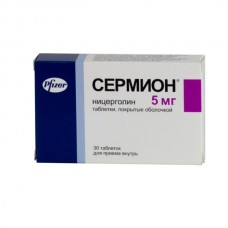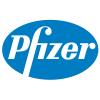Expiration date: 04/2026
Structure and Composition:
- Film-coated tablets. 1 tablet contains Nicergoline 5 mg
excipients: calcium hydrogen phosphate dihydrate, magnesium stearate, carboxymethylcellulose sodium MCC
sugar shell sucrose, talc, acacia gum, sandarac gum, magnesium carbonate, titanium dioxide (E171), rosin, carnauba wax, Sunset Yellow (E110)
in blister 15 pcs. In the paper cartons 2 blisters.
- Film-coated tablets. 1 tablet contains 10 mg of nicergoline
excipients: calcium hydrogen phosphate dihydrate, magnesium stearate, carboxymethylcellulose sodium MCC
sugar shell sucrose, talc, acacia gum, sandarac gum, magnesium carbonate, titanium dioxide (E171), rosin, carnauba wax
in blister 25 pcs. In the paper cartons 2 blisters.
- Film-coated tablets. 1 tablet contains 30 mg of nicergoline
excipients: calcium hydrogen phosphate dihydrate, magnesium stearate MCC sodium carboxymethylcellulose film coating
film coating: hypromellose, titanium dioxide (E171), polyethylene glycol 6000, iron oxide yellow (E172), silicon
in blister 15 pcs. In the paper cartons 2 blisters.
- Llyophilisate for solution for injection. 1 vial contains 4 mg nicergoline
Excipients: lactose monohydrate, tartaric acid
solvent: sodium chloride, benzalkonium chloride, water for injection
Patients in the 4 mg, together with the solvent in vials of 4 ml in a cardboard pack 4 sets.
Description pharmaceutical form:
Lyophilisate: freeze-dried powder or porous mass of white.
Solvent: clear, colorless liquid.
Tablets 5 mg: Round, convex, film-coated orange.
Tablets 10 mg: Round, convex, film-coated white.
Tablets 30 mg: Round, biconvex, coated yellow.
Pharmacokinetics:
After oral administration, nicergoline is rapidly and almost completely absorbed. Major metabolites nicergoline: 1,6-dimethyl-8 & beta-hydroxymethyl-10 & alpha-metoksiergolin (MMDL, hydrolysis product) and 6-methyl-8 & beta-hydroxymethyl-10 & alpha-metoksiergolin (MDL, demethylation product under the action of the isoenzyme CYP2D6). The ratio of AUC values ??for MMDL MDL and by ingestion and / in the introduction of nicergoline indicates a pronounced first-pass metabolism in. After receiving 30 mg of nicergoline inside Cmax MMDL - (21 ± 14) ng / ml MDL - (41 ± 14) ng / ml are achieved after approximately 1 and 4 hours, respectively, and then decreased with the concentration of MDL T1 / 2 of 13-20 hours. Studies confirm the absence of accumulation of other metabolites (including MMDL) in the blood. Eating or dosage form does not significantly affect the extent and rate of absorption of nicergoline. Nicergoline active (> 90%) binds to plasma proteins, and its degree of affinity for the & alpha-acid glycoprotein more than serum albumin. It is shown that nicergoline and its metabolites are distributed in blood cells. Pharmacokinetics nicergoline at doses up to 60 mg is linear and does not vary depending on the patients age.
Nicergoline is displayed in the form of metabolites, mostly urine (about 80% of the total dose) in a small amount (10-20%) - with the feces. In patients with severe renal failure showed a significant reduction in the degree of removal of metabolic products in the urine as compared to patients with normal renal function.
Description of the pharmacological actions:
Nicergoline - ergoline derivative, improves metabolic and hemodynamic processes in the brain, reduces platelet aggregation and improves hemorheological parameters of blood, increases blood flow in the upper and lower limbs, showing alpha1-adrenoceptor blocking action.
Indications:
- acute and chronic cerebral metabolic and vascular disorders (due to atherosclerosis, hypertension, thrombosis or cerebral embolism, including transient cerebral attack, vascular dementia, and headache caused by vasospasm)
- acute and chronic peripheral metabolic and vascular disorders (organic and functional arteriopathy extremities, Raynaud's disease, syndromes, peripheral blood flow caused by a violation)
- as an adjunct in the treatment of hypertensive crises (parenteral).
Contraindications:
- hypersensitivity to nicergoline and other ingredients
- acute bleeding
- acute myocardial infarction
- orthostatic hypotension
- bradycardia
Precautions: hyperuricemia and gout in the history and / or in combination with drugs that disrupt metabolism or excretion of uric acid.
Application of pregnancy and breastfeeding:
In the absence of specific studies during pregnancy Sermion should be used only if clearly needed and under the direct supervision of a physician. At the time of the drug necessary to abandon breastfeeding because nicergoline and its metabolic products penetrate into the mother's milk.
Side effect:
Rarely - marked reduction of blood pressure, mainly after parenteral administration, dizziness, dyspepsia, feeling of heat, skin rash, drowsiness or insomnia. May increase the concentration of uric acid in the blood, and this effect is independent of dose and duration of therapy. Side effects are usually easy or moderately expressed.
Drug Interactions:
Sermion may exacerbate the effects of antihypertensive drugs.
Sermion metabolized by the action of cytochrome CYP450 2D6, so we can not exclude the possibility of interaction with drugs that are metabolized with the participation of the same enzyme.
Dosage and administration:
Tablets of 5, 10 and 30 mg
Inside. 5.10 mg 3 times a day at regular intervals between doses for a long period of time (several months). In vascular dementia shows the use of 30 mg 2 times a day (at the same time every 6 months is recommended to consult with your doctor about whether to continue therapy).
Lyophilisate for solution for injection
V / m. 2.4 mg (2.4 ml), 2 times a day.
B / in by slow infusion. 4.8 mg in 100 ml of 0.9% sodium chloride or dextrose 5-10% by doctor appointment this dose may be administered several times a day.
B / A. 4 mg in 10 ml 0.9% sodium chloride solution administered the drug for 2 min. The reconstituted solution is recommended to be used immediately after preparation.
Dose and duration of therapy method of administration depends on the nature of the disease. In some cases it is preferable to start therapy with parenteral administration, and then go to the ingestion of the drug for the maintenance treatment.
Patients with impaired renal function (serum creatinine & ge2 mg / dL) Sermion recommended for lower therapeutic doses.
Overdose:
Symptoms: marked reduction of blood pressure transient.
Treatment: special treatment is not usually required, the patient is enough for a few minutes to take a horizontal position. In exceptional cases, a sharp violation of cerebral blood flow and heart recommended the introduction of sympathomimetic agents under the constant control of blood pressure.
Special instructions:
Sermion At therapeutic doses, usually has no effect on blood pressure, but in patients with hypertension, it can cause its gradual decrease.
After injecting Sermion recommended patients be in a horizontal position for several minutes after injection, especially at the beginning of treatment, due to possible occurrence of hypotension.
The drug acts slowly, so it should be taken for a long time, and the doctor should periodically (at least every 6 months) to evaluate the effect of treatment and appropriateness of its continuation.
Effects on ability to drive and use other mechanisms. Despite the fact that Sermion improves reaction and concentration, its effect on the ability to drive and use sophisticated techniques not been specifically studied. In any case, care should be taken, given the nature of the underlying disease.





